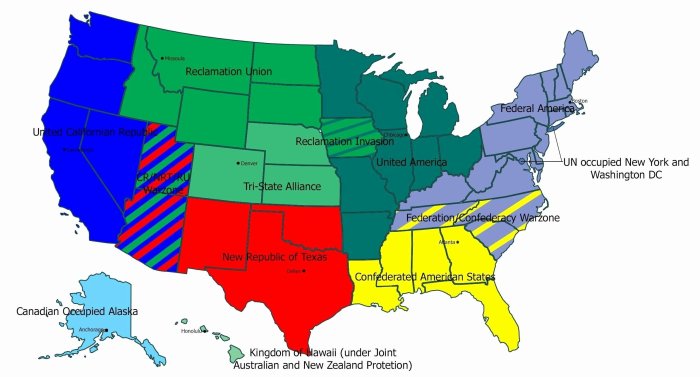Embarking on an exploration of the story of us civil war worksheet answers, this comprehensive guide delves into the intricacies of the American Civil War, unraveling its causes, major battles, technological advancements, and profound impact on American society. Prepare to immerse yourself in a journey through time, unearthing the pivotal events that shaped the nation’s destiny.
The Civil War’s Causes
The Civil War, which erupted in 1861, was a result of complex political, economic, and social factors that had been building up for decades. The most fundamental issue was the institution of slavery, which was deeply entrenched in the Southern economy and society but increasingly seen as morally repugnant and a threat to the Union by many in the North.
Other factors included economic disparities between the industrial North and the agricultural South, as well as political differences over the expansion of slavery into new territories and the power of the federal government.
Key events in the lead-up to the war included the Missouri Compromise of 1820, which temporarily resolved the issue of slavery in new territories, and the Compromise of 1850, which attempted to address the issue again but ultimately failed to prevent the outbreak of war.
The Union and Confederate sides had different perspectives on the causes of the war. The Union maintained that the war was fought to preserve the Union and end slavery, while the Confederacy argued that it was fought to protect states’ rights and the institution of slavery.
The Major Battles of the Civil War
| Battle Name | Date | Location | Union and Confederate Commanders | Outcome |
|---|---|---|---|---|
| Battle of Gettysburg | July 1-3, 1863 | Gettysburg, Pennsylvania | Union: George MeadeConfederate: Robert E. Lee | Union victory |
| Battle of Antietam | September 17, 1862 | Sharpsburg, Maryland | Union: George McClellanConfederate: Robert E. Lee | Union victory |
| Battle of Vicksburg | May 18
|
Vicksburg, Mississippi | Union: Ulysses S. GrantConfederate: John C. Pemberton | Union victory |
| Battle of Shiloh | April 6-7, 1862 | Shiloh, Tennessee | Union: Ulysses S. Grant, Don Carlos BuellConfederate: Albert Sidney Johnston, P.G.T. Beauregard | Union victory |
These battles were turning points in the war, and their outcomes had a significant impact on the course of the conflict. The Union victories at Gettysburg and Vicksburg helped to turn the tide of the war in favor of the North, while the Confederate victory at Shiloh gave them a temporary boost.
The Role of Technology in the Civil War
The Civil War was a turning point in the development of military technology. Both sides used new and innovative weapons and equipment, including rifles, artillery, ironclad ships, and railroads.
These advancements had a significant impact on the strategies and tactics employed by both sides. For example, the use of rifles allowed soldiers to fire more accurately and from greater distances, while the use of ironclad ships made it possible to attack enemy ships without having to worry about wooden hulls being destroyed by cannon fire.
Some of the most significant weapons and technologies used during the Civil War include:
- Rifles: Rifles were more accurate and had a longer range than muskets, which were the standard infantry weapon at the start of the war.
- Artillery: Artillery was used to bombard enemy positions and fortifications. The Union had a significant advantage in artillery over the Confederacy.
- Ironclad ships: Ironclad ships were warships that were protected by iron armor. They were used to attack enemy ships and fortifications.
- Railroads: Railroads were used to transport troops and supplies to the front lines.
The Impact of the Civil War on American Society

The Civil War had a profound impact on American society. The war led to the abolition of slavery, the freeing of four million slaves, and the end of the Confederacy.
The war also had a significant impact on the role of the federal government. The Union victory strengthened the federal government and established the supremacy of the Constitution over state laws.
The war also led to a number of social changes, including the rise of the Republican Party, the growth of the women’s suffrage movement, and the establishment of the Freedmen’s Bureau to help newly freed slaves.
The Civil War was a watershed moment in American history. It shaped the nation’s future development and continues to have a profound impact on American society today.
FAQ Compilation: The Story Of Us Civil War Worksheet Answers
What were the primary causes of the Civil War?
The Civil War erupted due to a complex interplay of political, economic, and social factors, including disputes over slavery, states’ rights, and the expansion of the federal government.
Which battle is considered the turning point of the Civil War?
The Battle of Gettysburg, fought in July 1863, marked a decisive Union victory that shifted the momentum of the war in favor of the North.
How did technology influence the course of the Civil War?
Advancements in weaponry, such as the development of the rifled musket and ironclad warships, transformed warfare and significantly impacted strategies and tactics.
What were the long-term consequences of the Civil War on American society?
The Civil War led to the abolition of slavery, the strengthening of the federal government, and profound changes in race relations and the nation’s economic and social fabric.
